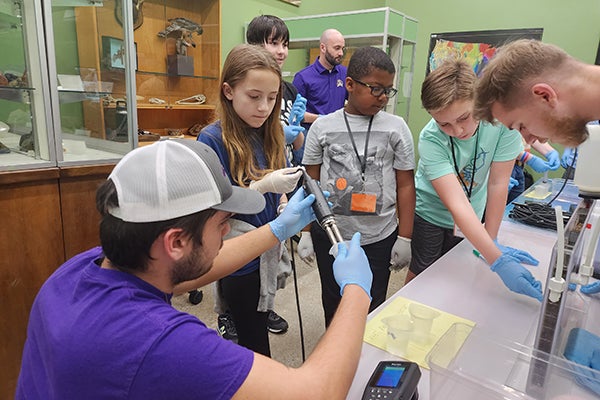ECU faculty, local business increase students’ scientific knowledge
An East Carolina University faculty member is collaborating with the North Carolina Museum of Natural Sciences at Greenville and its A Time for Science initiative to design and evaluate learning experiences for K-12 students to improve their scientific knowledge and interest in STEM-related fields.

Mary Krops, from Lenoir Community College’s Department of Nursing, shows students how to use high-fidelity simulators. (Photos contributed by Samantha Eubanks)
“ECU and A Time for Science are teaming up to propel young minds into science by introducing them to basic physics concepts and lab-based instruction. We hope to give students experiential learning opportunities,” said Dr. Francis Manno, assistant professor of physics and principal investigator on the $648,000 grant funded by the Office of Naval Research.
The program, known as Lab R.A.T.S. (Research and Advancement in Technology and Science), aims to promote scientific literacy, critical thinking and evidence-based decision-making by providing students in Pitt County with an engaging and enriching science education through a combination of lessons, seminars, colloquium and presentations. Programs will be at A Time for Science’s new location, 226 West Eighth St., which opens on Feb. 3.
Manno’s collaborators and co-principal investigators include ECU alumni and museum employees Emily Jarvis (College of Health and Human Performance, B.S. ’05) and Samantha Eubanks (College of Education, M.A.Ed. in science education, ’21).
“This partnership and grant are allowing us to expand our middle-school science outreach,” said Eubanks, education coordinator for the museum. “We are excited to expose more middle schoolers in Pitt County to the exciting research being done at ECU as well as exposing them to other STEM careers here in North Carolina.”
Over the next three years, the Lab R.A.T.S. program will be delivered throughout the school year to 600 Pitt County students. A Time for Science will host a monthly science showcase and provide participants the opportunity to engage with scientists and ask them about their research. Manno, along with a post-doctoral scholar, will develop tools to track and measure the impact and influence on the students, and they will collect and analyze the data each quarter.
In addition, the program aims to strengthen STEM continuing education for secondary teachers. Facilitated by professors, the program will provide workshops in STEM-related fields to assist teachers in bridging contemporary concepts with their students.

ECU’s Water Resources Center visited A Time for Science and led students through a simulation dealing with the salination of soil and contamination of water sources.
According to Manno, the program fills a gap for both urban and rural students who lack access to certified teachers and resources relating to STEM fields like physics, chemistry and biology.
“Lab R.A.T.S. aims to create an outreach-based STEM education program that meets the needs specific to our community here in eastern North Carolina,” he said. “By introducing young learners to field experts and working scientists, as well as creating options to engage with science in a fun way, we are allowing students to see themselves in STEM-based careers.”
Manno’s long-term goal is to expand and share the program with educators beyond eastern North Carolina and Pitt County.
“We hope to create a tool that other communities can use to boost their students’ interest in science, engagement with scientific research and desire to pursue a career in STEM,” he said.
For more information, visit the museum’s website.